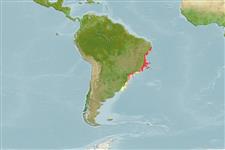Meioceras nitidum (Stimpson, 1851)
Little horn caecum| Native range | All suitable habitat | Point map | Year 2050 |

|
| This map was computer-generated and has not yet been reviewed. |
| Meioceras nitidum AquaMaps Data sources: GBIF OBIS |
Google image |
No photo available for this species.
Classification / Names Populärnamn | synonymer | CoL | ITIS | WoRMS
Gastropoda | Littorinimorpha | Caecidae
Environment: milieu / climate zone / djupintervall / distribution range Ekologi
Revassocierade; djupintervall 0 - 24 m (Ref. 109264). Tropical; 8°S - 35°S, 56°E - 35°E (Ref. 83435)
Distribution Länder | FAO områden | Ekosystem | Förekomster | Utplanteringar
Western Atlantic: North America.
Length at first maturity / Size / Weight / Age
Könsmognad: Lm ? range ? - ? cm Max length : 0.3 cm DL hane/ej könsbestämd; (Ref. 83435)
Life cycle and mating behavior Könsmognad | Reproduktion | Lek | Eggs | Fecundity | Larvae
Main reference
referenser | Koordinator | Medarbetare
Miloslavich, P., J.M. Díaz, E. Klein, J.J. Alvarado, C. Díaz, J. Gobin, E. Escobar-Briones, Motta, J.J. Cruz, E. Weil, J. Cortés, A.C. Bastidas, R. Roberston, F. Zapata, A. Martín, J. Castillo, A. Kazandjian and M. Ortiz 2010 Marine biodiversity in the Caribbean: regional estimates and distribution patterns. PLoS ONE 5(8):e11916. (Ref. 86671)
IUCN Red List Status
(Ref. 130435: Version 2025-1)
CITES status (Ref. 108899)
CMS (Ref. 116361)
Threat to humans
Human uses
| FishSource |
Verktyg
Ytterligare information
Födosammansättning
Födointag
Predatorer
Max. ages / sizes
Length-weight rel.
Length-length rel.
Length-frequencies
Mass conversion
Abundans
Internet-källor
BHL | BOLD Systems | CISTI | DiscoverLife | FAO(Publication : search) | Fishipedia | GenBank (genome, nucleotide) | GloBI | Gomexsi | Google Books | Google Scholar | Google | PubMed | Tree of Life | Wikipedia (Go, sök) | Zoological Record


